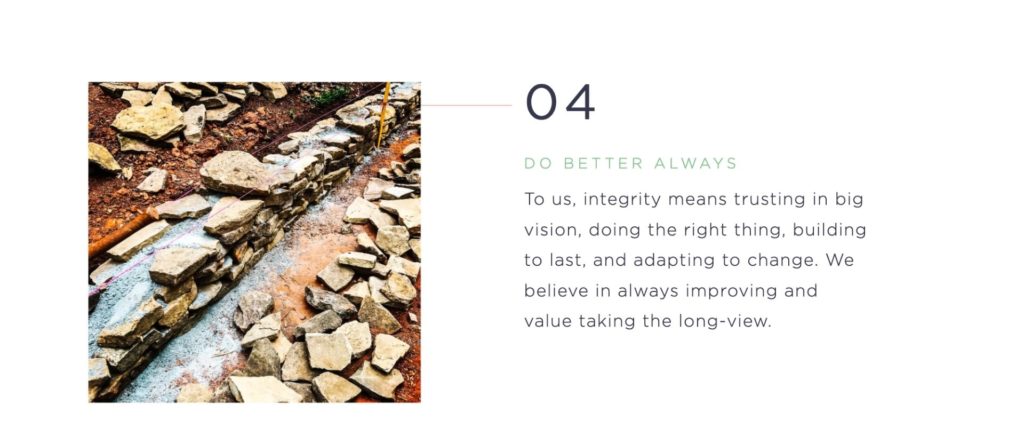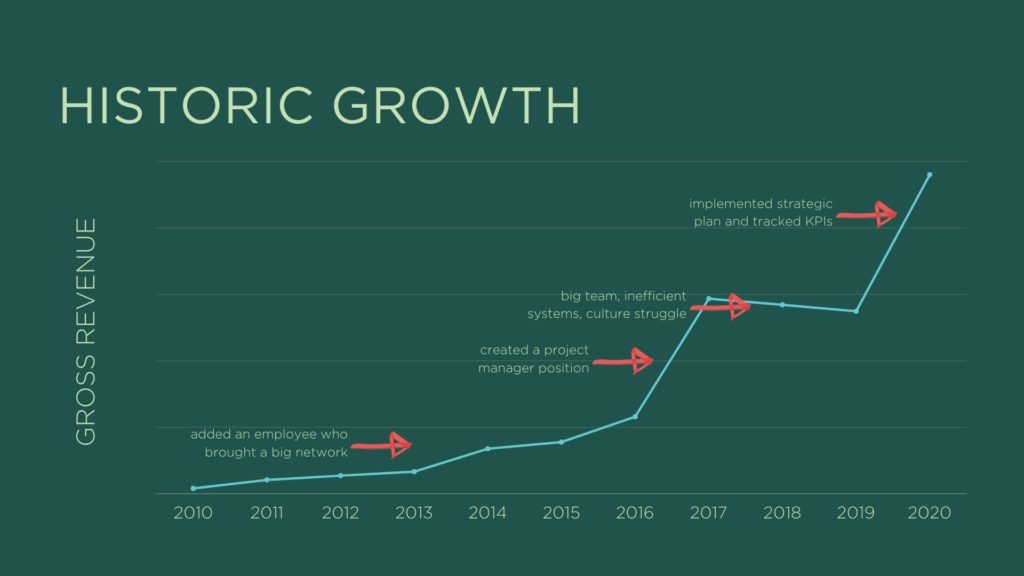I recently wrote a post about financial transparency and open-book management and had some wonderful questions and responses come in. Many asked if I had any insight into building a company that could support moving to financial transparency since it is a departure from the standard fiscal management strategy for many companies.
So, I thought about where we are in our growth at Shades of Green and how we’ve gotten there. We’ve had a few defining moments that have set us on a path of intentional and strategic growth, and I’ve distilled those lessons in hopes that they can help you think about scaling your business organically.
Here’s a quick history of Shades of Green, as it has grown from me working solo at my kitchen table to a full-time, year-round staff of 13 people and counting.

Step 1: Organize around your company values, and hold yourself accountable to them.
I made the same mistakes that I think many entrepreneurs make. I hired my first employee to take things off of my plate, expecting them to be able to do exactly what I had been doing without any systems to support them, hold them accountable, or help in their training. Rinse and repeat, I did that a couple of times until we were a team of 5 people and we needed clear systems that we could all hold each other accountable to, and we needed to begin defining what makes us, us. I’ve mentioned before the impact of doing the Small Giants Leadership Academy, and it was at this point in the company that I felt I needed support to step into a role of leadership that benefited the team. Small Giants are passionate about defining your organization’s vision and rallying around core values that set you apart as an organization and motivate you to show up day in and day out. So, the next thing we did was a massive brain dump of everything we could think of that sets us apart and defines us as an organization. Then we organized these into groupings that became our four core values.


Step 2: Build a company culture that makes you proud.
We think of company culture as the norms and habits of how we behave, communicate, and interact. It is the collective beliefs we share about the work and how we want to do it. Once we defined our core values, we were able to see and enrich our culture based on them by reiterating the values, organizing our work around them, and holding one another accountable to them. For example, “do better always” is our rallying cry. We even have a joke, “who’s bright idea was that?” because it means we are always pushing ourselves to learn from our mistakes and get better because of them. When something goes wrong, whether it is a swale that blows out or a meeting that gets missed, we work together to find the solution collectively and integrate it for the future by codifying it in our process vs. seeking to blame and punish. If one person makes a mistake, we truly see it as the whole company making a mistake because it’s a failure of process and an opportunity to get better. An ecological parallel is the process of succession. Permaculture seeks to accelerate succession through water infiltration, rapid soil building, and using pioneer species. We have integrated this into our culture by accelerating our own succession through intentional feedback loops based on values and organized around our purpose.

Step 3: Gather data, analyze it, and act upon it.
Today, we have a sophisticated Customer Relationship Management software (CRM) that tracks intentional Key Performance Indicators (KPIs), which are tied to our strategic plan. That is not at all where we started. We started by asking relevant questions and analyzing spreadsheets ad nauseam. What is the difference between a lead call that converts into our sales pipeline and one that does not? How much water did our projects collectively harvest last year? How many trees did we plant? Where are our clients coming from, how did they hear about us? When you know what works, you can do more of it. This step to organic growth is reflected in the permaculture principle: observe and interact. What is happening, and how do you interpret it? Collecting relevant data allows you to make incremental changes based on informed viewpoints. For instance, once we started looking at where our leads came from, we could strategically put more resources into that lead source (i.e., our website). This has had a significant impact on our growth.
Step 4: Shorten your lead-sales cycle
Shortening our lead to pipeline cycle is one of the biggest things that we have done to improve efficiency, which is reflected here in this chart:

We did this by improving efficiency around scheduling as a first step. In the beginning, someone would reach out; then we would play phone tag for ten days, then we would finally connect and be able to schedule an initial consultation. So, when we identified this based on how long the time was between the initial lead call and scheduling a consultation, it became a really easy decision to upgrade to scheduling software to shorten the time frame.
Another decision we made recently when our hand was forced because of the pandemic was to do all of our initial consultations remotely. At first, we were resistant because it is so important to have eyes on the site but soon realized that the initial consultation we have is generally to orient to the site and discuss project goals and visions, which is absolutely workable through remote video conferencing. Then, should the client move forward, we still do our in-depth site analysis visit. Making this simple shift has allowed us to reclaim hours of each workday that had previously been spent driving back and forth. An additional bonus is that we have significantly reduced our carbon footprint in the process, which ties back to our values! Win-win! Remote consultations have also allowed us to shorten the lead-sales cycle because we can schedule them more frequently; getting to more people sooner and closer to the time when working with us was top of mind.
Finally, The most impactful addition to our team in the early stages of growth was building out a project management role. This did two things: 1) it forced us to systematize our process, and 2) it became someone’s designated responsibility to move projects forward.
Step 5: Complete a strategic plan.
This is where it all comes together and is certainly not unique to our company. However, as a small business, trying to devote the resources and time to a strategic planning process was a big stretch. We made it work one meeting at a time and found the process invaluable. And now, we do it annually. Like a permaculture system, this is a lot of energy on the front end, but the stage is then set for fertility and rapid growth. Ultimately, it freed up more energy because we knew that our work was strategic, pointed, and intentional, which made it count more than it would have if it were unorganized and meandering. Strategic planning allowed us to get upstream of many daily stressors and ground us in common goals that we can come back to collectively.
Strategic planning was the flowering of the other steps mentioned here. It brought together our company values and the delivery system for those values⏤our culture. And all of the work was informed by real-time data. Part of defining our purpose and vision gives us meaning as an organization to continue to show up every day to build our company’s complexity, intricacy, and stability. At this point, the strategic plan and how we execute our work is a self-informed feedback loop that continues to improve because the systems are in place to do so.
If I had to distill our growth (and our collective culture shift) into its essential parts, it really comes back to our four values of taking care of each other, doing better always, welcoming the unexpected, and working like nature for nature. Our values are reflected in what we do and how we do it, so our growth is sustainable, organic, and intentional. If this interests you, and you want to dive deeper, I highly recommend connecting with the Small Giants Community (smallgiants.org), researching B-Corporation ethics and standards (bcorporation.net), and reading Traction, by Gino Wickman.

